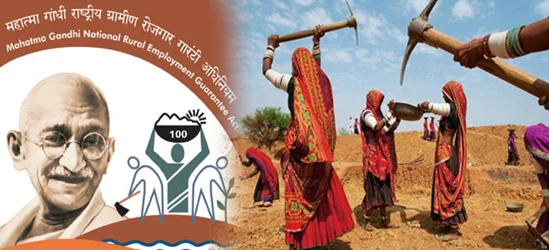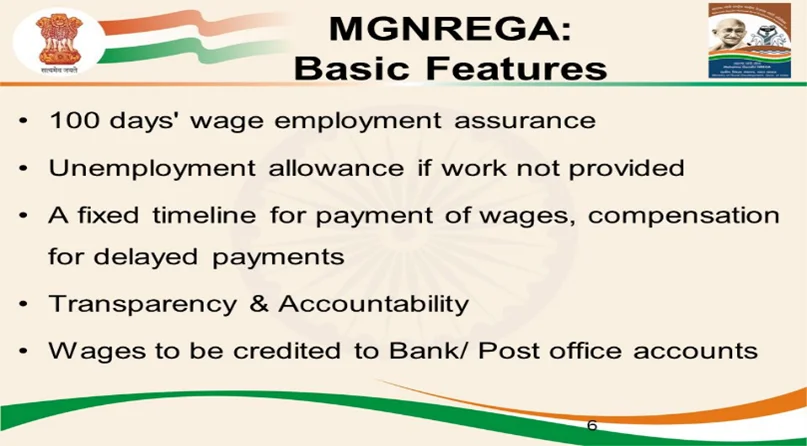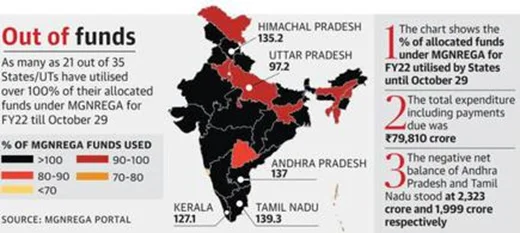Governance
Context: The Central government has constituted a committee to review the implementation of the Mahatma Gandhi National Rural Employment Guarantee Act (MGNREGA) scheme, especially to assess the programme’s efficacy as a poverty alleviation tool. The committee, headed by former Rural Development secretary Amarjeet Sinha.
About MGNREGA:

- It is a poverty alleviation programme of the Government of India, which provides the legal Right to Work in exchange for money to the citizens of the country.
- On average, every day approximately 1.5 crore people work under it at almost 14 lakh sites.
- It aims to enhance livelihood security in rural areas by providing at least 100 days of guaranteed wage employment in a financial year to every household whose adult members volunteer to do unskilled manual work.
- Funding: It is shared between the Centre and the States.
- The Central Government bears 100 per cent of the cost of unskilled labour, 75 percent of the cost of semi-skilled and skilled labour, 75 percent of the cost of materials and 6 percent of the administrative costs.
- Current employment: There are currently 15.51 crore active workers enrolled under the scheme.
Features of MGNREGA scheme:

- Legal Right to Work:
- The Act provides a legal right to employment for adult members of rural households.
- Women labour force:
- At least one-third of beneficiaries have to be women. Wages must be paid according to the wages specified for agricultural labourers in the state under the Minimum Wages Act, 1948.
- Time-Bound Guarantee of Work:
- Employment must be provided within 15 days of being demanded to fail which an ‘unemployment allowance’ must be given.
- Decentralised Planning:
- Panchayati Raj Institutions (PRIs) are primarily responsible for planning, implementation and monitoring of the works that are undertaken.
- Gram Sabha’s must recommend the works that are to be undertaken and at least 50 per cent of the works must be executed by them.
- Transparency and Accountability:
- There are provisions for proactive disclosure through wall writings, Citizen Information Boards, Management Information Systems and social audits (conducted by Gram Sabha’s).
Significance of the scheme:
- It is a social security scheme to generate employment for the rural poor and ensure livelihood for people in rural areas.
- The scheme sees large-scale participation of women, Scheduled Castes (SCs) and Scheduled Tribes (STs) and other traditionally marginalised sections of society.
- It increases the wage rate in rural areas and strengthens the rural economy through the creation of infrastructure assets.
- It facilitates sustainable development which is very clear by its contribution in the direction of water conservation.
- The program provided a sigh of relief to millions of migrants and other people who lost their livelihood in the pandemic times. The scheme ensured that the vulnerable get access to basic income thereby decreasing suicide rates in the country.
- The scheme has led to the creation of common community assets. These assets are built by communities on common lands thereby creating a sense of responsibility towards the structure which results in better care.
- For instance, many Johads (percolation ponds) and check dams had remained abandoned for several years in many villages of Karnataka. However, villagers revived them under the MGNREGA.
Performance of MGNREGA during Covid-19 Pandemic:
- According to the government data, over 11 crore people worked under MGNREGS during the financial year 2020-21 alone. Few other achievements of the Scheme last year are,
- This is the first time since the launch of the scheme in 2006-07 that the MGNREGS numbers crossed the 11-crore mark in a year.
- Further, the 11 crore mark is also higher by about 41.75% if we compare 2019-20 data (about 7.88 crores worked).
- In 2020-21, the total expenditure was 62.31% higher than in 2019-20.
- As part of the economic package during the Covid-19 pandemic, the government announced additional funding of Rs 40,000 crore for the MGNREGS over and above the budgetary allocation of 2020-21.
Issues with MGNREGA:
- Poor maintenance: Many structures created under MGNREGA become defunct due to poor maintenance. This simply implies the wastage of time, energy, and resources.
- Data on the impact of productive assets: The government does not monitor whether a structure has actually helped water conservation. Further, there is no government data on the impact on groundwater levels, improvements in livelihoods etc. post the creation of assets.
- Inadequate Funds: A huge surge in demand for MGNREGA works has been witnessed in pandemic times. But the government hasn’t duly allocated funding in a similar proportion.

- Insufficient support: With the unemployment rate reaching a 45-year high at 6%, giving merely 100 days of employment is not sufficient.
- Payment Delays: Despite Supreme Court orders, various other initiatives and various government orders, no provisions have yet been worked out for calculation of full wage delays and payment of compensation for the same.
- Corruption and Irregularities: Funds that reach the beneficiaries are very little compared to the actual funds allocated for the welfare schemes.
- Discrimination: Frequent cases of discrimination against women and people from the backwards groups are reported from several regions of the country and a vast number goes unreported.
- Non-payment of Unemployment Allowance: There is a huge pendency in the number of unemployment allowances being shown in the Management Information System (MIS).
Suggestion measures:
- There is a need to carry out social audits as per rules and effective implementation of the delay compensation system.
- The participation of women and backwards classes must be increased by raising awareness and making it more inclusive.
- The people should be sensitised to do away with the discrimination against them.
- Reasons for poor utilisation of funds should be analysed and steps must be taken to improve them.
- In addition, actions should be initiated against officers found guilty of misappropriating funds.
- Villages must also be allowed to take control of their own water security, noting that catchment areas for many villages are on land controlled and owned by the Forest Department.
- The government should provide greater funds for the proper implementation of the scheme. It currently provides 0.47% of GDP while the World Bank recommends 1.7 % for the optimal functioning of the program.
- The frequency of monitoring by National Level Monitors (NLMs) should be increased and appropriate measures should be taken by States based on their recommendations.
The National Rural Employment Guarantee Act (MGNREGA) 2005 is a milestone in India’s history of post-independence social security laws. Made after a successful legal struggle to secure employment, it is a partial victory for the full right of employment in any developing country. An important aspect of this law that distinguishes it from any other public service delivery system is its defeat by the Indian parliament.
Thus, the MNREGA programme has definitely brought about development in rural households, allowing them to access many facilities and improve the quality of their lives.
Source: The Hindu













